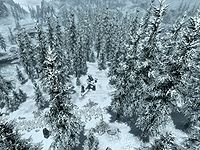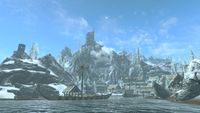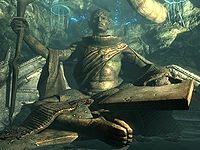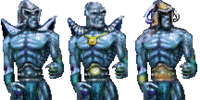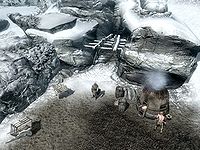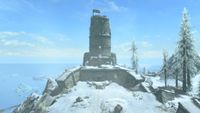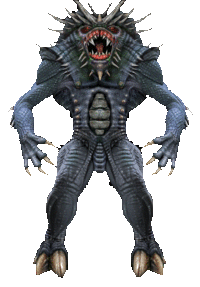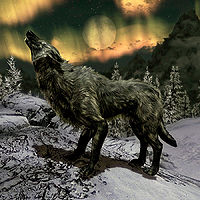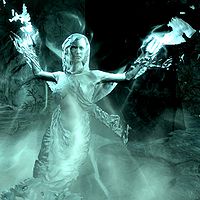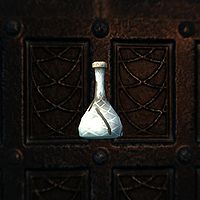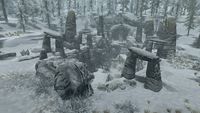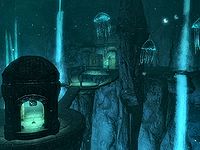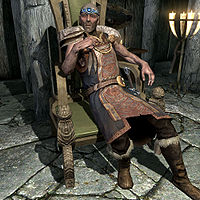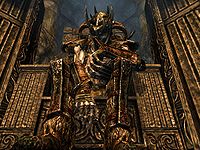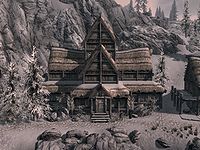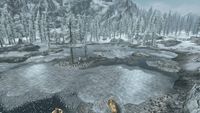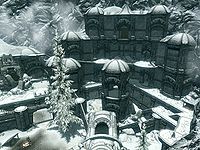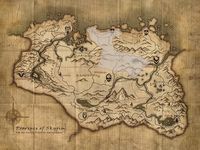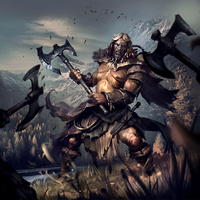Lore:The Pale
| The Pale | |
|---|---|
| Type | Region |
| Continent | Tamriel |
| Province | Skyrim |
| Subregions | Frozen Coast Giants' Gap Pale Mountains |
| Appears in | Dawnstar, Skyrim |
The Pale (also called the Pale Hold)[1]:457 is a large region in north-central Skyrim and one of the Old Holds, the original four territories in the province, where ancient traditions continue to thrive.[2] The region acquired its name from both the pale white tundra and the pigmentation of the local Nords. Because of its distinct shape, some people colloquially call it "the old boot". The hold's population is centralized in its capital city of Dawnstar, a seaside town on the Frozen Coast and one of the busiest ports in the province.[1]:454[3]
The Pale is divided by the snow-white landscape of the north coast and the frosty pine forest around the southern mountains. Lake Yorgrim is centered around this southern region and the mountain, Shearpoint marks the border between holds.[4] The Pale is traditionally bordered by Eastmarch to the southeast, Hjaalmarch to the west, Whiterun Hold to the south, and Winterhold to the northeast.[5]
Contents
Society and Geography[edit]
Demographics[edit]
The Pale's main demographic is the Nords,[6] whose pallid complexion partially inspired the region's name. Since much of the region is inhospitable for most and lacks sunshine, the hold's population is centered in Dawnstar, the capital on the northern coast and its main center of commerce.[1]:454 Some people in the Fourth Era owned private property in the southernmost ends of the Pale, such as the lumbermill built by Anga on the River Yorgrim,[7] the farmstead owned by the Loreius family,[8] and Nightgate Inn on the road between the Pale and Eastmarch.[9] Heljarchen is a historical settlement found around the lowlands near Whiterun Hold.[10][11]
Giants are commonplace in the Pale,[12] especially around the Skyborn Range and southern Pale Hold where some camps litter the area.[4] Sea Giants, on the other hand, are rarely seen across mainland Skyrim but make landfall during the winter on the Frozen Coast,[13] the northern coastal region that spans much of the Pale and spills into Hjaalmarch.[14] This race of intelligent giants live predominantly on the Sea of Ghosts and are shrouded in legend.[13]
The Dwemer migrated to Skyrim and sought to exploit the land for a rare material under the earth.[15] Most of the Dwemer population in the Pale were based in the southern region around Lake Yorgrim. Two Dwemer ruins can be found on the northern face of Shearpoint and south of the lake; Irkngthand, found in a valley at the base of the mountain and Raldbthar, a former city-state higher on the mountain and southeast of Irkngthand. But across the southern Pale Hold are hidden Dwemer lifts that provide access to Blackreach, a vast and legendary realm underneath most of Skyrim. Raldbthar's lift is just next to the city's entrance but the Tower of Mzark, however, stands on a hillock that looks over the Whiterun plains and Pale forest.[4]
The Falmer of Skyrim seldom live in the region but have conclaves in the deepest parts of the hold, such as caves like Duskglow Crevice.[4] Most of them live in Blackreach, ever since their ancestors were defeated by the ancient Nords and taken in by the Dwemer. Through deception, they rendered the Falmer feeble and blind and kept them as thralls and servants.[16] In secret, the slaves of Irkngthand built a large statue of a Snow Elf deep in their holdings with eyes made of large white gemstones.[17] It is currently one of the only known visual representation of the Snow Elves before their current state.[18]
Outside of Dawnstar is a race of blue-skinned humanoids called the Ice Tribes, who are also found in the Western Reach. They have been known to inhabit several unique dungeons such as Ice Tribe Haven and Ice Council.[19] Vampires have an ancient history in Skyrim,[20] originally dating back to the first Vampire Lamae Beolfag, whose screams became the Shrieking Winds and still howl across Skyrim's winding fjords.[21] Dimhollow Crypt, a ruin in the Pale mountains has a direct connection to the Volkihar Clan.[20][22]
Culture and Industry[edit]
The Pale celebrates the arrival of spring with the High Spring Fest. A particular tradition is the consumption of Bjenost, which marks the end of winter and the arrival of spring. This type of cheese may have originated among the poor of the hold but has become a delicacy between locals of any standing. As the snow thaws, rinds and crumbs of cheese consumed over the course of winter are soaked in ale and stuffed in pork intestines to create Bjenost. It is then hung out to dry and taken down for the High Spring Fest, where it is sliced in gold disks resembling the springtime sun.[23] Some would say that even in springtide, the Pale is very cold.[24]
Dawnstar's economy is mainly driven by its two mines found in separate parts of the city. The people often find meaning within the stones.[1]:457 The Iron-Breaker mine is located at the base of a mountain, in the southeast corner of town and supplies Dawnstar with iron, while the Quicksilver mine on the western bay shore extracts the eponymous metal, quicksilver.[4] By the Fourth Era, the mines' proprietors, Beitild Iron-Breaker and Leigelf Quicksilver were married together but had a bitter rivalry.[25][26]
Dawnstar is significant as a port because it is the last stop toward Windhelm that is not ice-bound. However, people regularly deal with raiders, wildlife, and even the weather to make sure commerce runs smoothly. The town's main port of call is Northstar Port, which is built into the bay.[1]:457 Fort Dunstad was built by the Imperial Legion as both a checkpoint on the Pale's main road and the prison for some of Skyrim's worst criminals.[1]:463 Sometime after the death of the Akaviri Potentate, Savirien-Chorak, the Dark Brotherhood rose in infamy after their involvement.[27][28] The guild of assassins built one of their first sanctuaries in the north coast just outside of Dawnstar.[29]
The Pale has a complicated history in regards to daedric worship around Mehrunes Dagon as it pertains to one of Dawnstar's oldest families, the Vesuius Imperials.[30] In their time, they were influential traders but underneath that visage, they were faithful servants of the Daedric Prince. One member was even chosen to assassinate Emperor Uriel Septim VII. The Oblivion Crisis broke out soon after and although it ended within the year, the destruction resonated within everyone and the Vesuius family hid their true involvement in the conflict. That was until their secret came out well after the crisis[31] and they became outcasts ever since.[30] At some point in time, a large statue of Mehrunes Dagon was built on the Pale highlands, and the Mythic Dawn used it as a base.[32]
Several decades prior to 4E 201, the Tower of the Dawn was taken over by a cult of Vaermina worshippers, who turned it into Nightcaller Temple. Ever since an attack on the temple, the tower was left abandoned and the Skull of Corruption remained in isolation.[33] Many people responded to the Oblivion Crisis by forming factions to combat daedric and other dark forces across Tamriel. One such group was the Vigilants of Stendarr,[34] who built their main headquarters in the Pale, northwest of Fort Dunstad.[35]
Ecosystem[edit]
The Pale sits on the northern coast of Skyrim, where the snow-blown north meets the chilled Sea of Ghosts. It is described as a barren realm[3] but life finds a way to thrive in an otherwise inhospitable terrain. The region's southern half is a boreal pine forest between the mountains and Whiterun's tundra.[4] Snowberry bushes, which can only be found in Skyrim's higher altitudes exist across the countryside[36] while the three main varieties of mountain flowers are strewn across the main road.[4] On the coastal line, spiky grass can be found in droves[37] unlike the Nirnroot, which is seldom seen on the Frozen Coast.[38]
Animals and other creatures make their home in the Pale's wilderness, from the more commonly seen wolf and frostbite spider, to the larger bear, sabre cat, and even troll. In the deep wilderness, however, one can run into spriggans in isolated groves or ice wraiths dwelling in the snow.[4] There are even some creatures of ill-repute that have called the Pale their home, such as the Udefrykte, a legendary troll[39] and the Gehenoth, a creature that the Ice Tribes once used to attack Dawnstar.[40]
The Pale has access to not just the saltwater of the Sea of Ghosts, but the freshwater from Lake Yorgrim and its river. In the region's freezing waters, fisherfolk can find common fish such as the abecean longfin and the arctic grayling, one can also find uncommon fish like the arctic char and cod, and even the rare angler.[41] Even other aquatic creatures like clams and nordic barnacles can be found in the Pale.[4]
History[edit]
- For the history specific to the city, see the: History of Dawnstar
Early History[edit]
The Nords first settled the Pale sometime in the late Merethic Era with traces of this time still present into the modern-day.[4] Silverdrift Lair is a Nordic barrow in southern Pale Hold and one of its tombs belonged to the Ice-Blade Clan of Jehanna, a wealthy family in High Rock.[42][43] Frostmere Crypt is actually a secret prison for a mythical figure called Aumriel. According to ancient records, this spirit battled Ysgramor's heirs over decades until her defeat. Her legend lives on with the locals of nearby Morthal as "the Pale Lady", who wanders the Drajkmyr marsh and steals children.[44]
The White Phial is a legendary artifact of magical renown, forged in "the days when Skyrim was just starting its turn to ice". It was crafted by Curalmil and buried with him in his tomb in southern Pale Hold.[45] One of the few relics of Skyrim's ancient vampire history is Dimhollow Crypt, an underground complex in the Skyborn Range of southwest Pale Hold.[20][22]
In the late Merethic Era, the Dragon Cult was prominent across ancient Skyrim and their ruined temples dot the province.[46] While few of these temples exist in the Pale, there are some worth noting.[4] High Gate Ruins are found on the border between the Pale and Hjaalmarch and it housed the Dragon Priest, Vokun.[47] At the top of Shearpoint is a sarcophagus to the Dragon Priest, Krosis.[48]
The Dragon Cult was diminished in the wake of the Dragon War and out of this conflict was the rise of Tongues, masters of the thu'um.[46] Some of these people became legendary warriors in Skyrim's history, such as Kvenel the Tongue, who was buried in a former settlement called Volunruud. There was once an ancient Nordic clan of proficient tongues, but one member, Oskar the Fool was not as talented. Regardless, he was honored by his brother, Modir the Far with a word wall erected on Shearpoint next to Krosis' tomb.[49] In the early First Era, sometime after the Dragon War,[50] portions of the modern-day Pale Hold were previously part of the neighboring Whiterun Hold, namely Volunruud and Korvanjund.[51]
The Pale in the First and Second Eras[edit]
By the early First Era, Skyrim was ruled by High King Borgas, a loyal supporter to the monkey-prophet, Marukh and his faith. This support, however, was what took his life as he became a victim in the Wild Hunt of Valenwood in 1E 369.[52] In secret, Borgas' body was returned to Skyrim and buried in Korvanjund, but as most people know it, both him and his crown, the Jagged Crown were lost to time.[53][54]
Since Borgas died without an heir, the War of Succession split Skyrim asunder and spelled the end of the Nordic Empire.[54] The Jarls of Skyrim sought control after the death of Ysgramor's dynasty but fell flat until Olaf One-Eye's rise to power.[55] A byproduct of the War of Succession was the Nords' expulsion from Resdayn and the formation of the First Council, an alliance of Chimer and Dwemer.[56][57] But this new era of prosperity did not sit well with certain Dwemer groups and caused a great exodus of clans to the west.[15]
The path was first set by the Rourken Clan, who may have settled in Irkngthand before, according to Thelwe Ghelein,[58] and many others followed suit to then settle across Skyrim. One of the most successful clans was the one to build Raldbthar in southern Pale Hold,[15][59] who may have settled in the area since at least 1E 240.[60] This city-state was one of four in a pocket empire that sought the excavation and research of a rare, blue material called Aetherium.[15][61] Raldbthar was the primary source for Aetherium and the Dwemer built their mine deep in Shearpoint mountain.[59]
Despite the prosperity, Dwemer society in Skyrim was on a rapid decline, starting with the Aetherium Wars. The city-states engaged in war with other clans and against each other, which weakened Dwarven civilization as a whole. What followed was High King Gellir's conquests over modern-day Skyrim, which hastened their downfall in the span of three years. Even though it took them a century later to reclaim most of their territory, scholars found no evidence that Aetherium research and excavation continued.[61]
Since the death of the Snow Prince in the Merethic Era, the Snow Elves fled into parts unknown to avoid the Nords and their wrath. They found refuge in Blackreach underneath Skyrim and came into contact with the Dwemer. However, through deception and underhanded tactics, the Dwemer were able to enslave the Snow Elves and bend them to their whim. Despite their inherent weakness and blindness,[16] the slaves of Irkngthand were able to build an impressively large statue of a Snow Elf before their encounter with the Dwemer.[17] In time, the slaves revolted and fled further down Blackreach. Decades ever since, both sides engaged in a bloody conflict that the scholar, Ursa Uthrax calls the War of the Crag. This came to an abrupt stop when the Dwemer mysteriously vanished and left no traces of their whereabouts.[16]
When the Tsaesci of Akavir first invaded Tamriel in the late First Era, Reman I built a protective shield across the northern coast of Skyrim to defend it against future threats.[62] In the latter years of his empire, it was governed by the Akaviri Potentate, Versidue-Shaie, who owned a fortress in Dawnstar. In 2E 283, it was destroyed by local rebels, one of many factions from the various vassal kingdoms across Tamriel. The Potentate gathered the Elder Council to Bardmont, a town south of Dawnstar where he ordained the Council of Bardmont and declared universal martial law. What followed was thirty-seven years of blood and violence[63] called the War of Subjugation.[64]
The Second Empire and the culmination of Potentate rule ended with Savirien-Chorak's assassination in 2E 430,[27][54] but what affected Skyrim the most was High King Lorgrolf's death a year later.[54] The schism that his death created brought about two separate kingdoms in Skyrim, the western kingdom based in Solitude and the eastern kingdom in Windhelm.[54] The Old Holds, including the Pale, joined together with Logrolf's daughter, the newly-named High Queen Freydis to form this new country in the east. By the time Jorunn the Skald-King was pronounced leader, the eastern kingdom, along with the Dark Elves of Morrowind and Argonians of Black Marsh became the Ebonheart Pact.[UOL 1]
The Pale and the Third Empire[edit]
By the Third Era, the Pale and the holds governed under a kingship.[65][66] Under Uriel Septim III's lead, the disgruntled kings of Skyrim fought in the War of the Red Diamond, a civil war against the Third Empire under Empress Kintyra II.[67] When Uriel III was defeated at the Battle of Ichidag, his uncle succeeded him as Emperor Cephorus I and many people formerly loyal to Uriel III turned coat to the new Emperor. The nobles of Skyrim and the other provinces received new levels of autonomy and independence,[68] although when the war ended, Emperor Magnus I spent much of his short reign punishing the kings that defied the Empire.[69]
By roughly 3E 427,[UOL 2] Dawnstar was an outpost ruled by Governor Cyril Vinticae. The town was besieged by the Ice Tribes, with help from a traitor within. When the traitor and three other champions returned to Dawnstar, they were banished to the wilderness. The Governor enlisted an adventurer to find the traitor among them, return with the other champions, and prepare for a final assault on the town. After discovering the traitor, the adventurer fought in the battle to save Dawnstar, and for finding them, the Governor awarded them with the Starfrost. It was a magical frost that focuses the prayers of Dawnstar's people and elemental winter into its wielder. With it, they were able to defeat the Ice Tribes and the Gehenoth Thriceborn, becoming the Hero of Dawnstar.[70]
The late Third Era was a significant moment in time for the Pale and its capital Dawnstar. Queen Macalla married King Thian of nearby Solitude and in turn, expanded Solitude's influence across most of the northern coast. Together, they also incorporated former Imperial fiefs, such as Roscrea and territory beyond the Sea of Ghosts.[66] Despite the prosperity, the Pale was affected by the Oblivion Crisis in 3E 433, along with the rest of the Old Holds.[71]
The Fourth Era and onward[edit]
Well into the Fourth Era, Dawnstar and its environs were now separate entities from Solitude.[4] A priesthood that venerated Vaermina took up residence in the Tower of the Dawn and built Nightcaller Temple from within. They were in possession of the Skull of Corruption, which inflicted neverending nightmares on many people. An Orcish war party attacked the temple after suffering from said nightmares but the priests retaliated by unleashing the Miasma, a magical smoke that puts people to sleep for potentially years. Ever since then, the tower has been abandoned with the Skull of Corruption hidden in its deepest chamber.[33]
By the latter half of the second century, the Pale is ruled by Jarl Skald Felgeif, who partook in the Skyrim Civil War as a faithful supporter of Ulfric Stormcloak and the divine, Talos.[12] The Stormcloak garrison based in Dawnstar was led by Frorkmar Banner-Torn[72] and Fort Dunstad played an important role in the hold's allegiance.[73]
In 4E 201, Galmar Stone-Fist, Ulfric's second-hand was able to deduce High King Borgas' resting place as Korvanjund and he prepared his soldiers for a retrieval mission.[53] Spies enlisted under the Imperial Legion were able to confirm Galmar's suspicions to Legate Rikke and a confrontation ensued afterward in the crypt.[74] Details on this battle are unknown, but one faction was only able to reach the Hall of Stories and the puzzle door, while the other faced the undead Borgas and retrieve the crown.[75][76]
In that same year, the Skull of Corruption infested Dawnstar with nightmares, and a priest of Mara named Erandur arrived to vanquish the threat. With the help of an adventurer, they set out to Nightcaller Temple. As they traveled through the dungeon, they fought the Orcs and Vaermina cultists that remained there since the last attack. What became of the Skull of Corruption and Erandur are unknown, but Dawnstar was eventually free from nightmares.[77] At around the same time, the Hall of the Vigilants was destroyed by the Volkihar Clan, an ancient order of vampires. It was the first of many attacks in a conflict that pitted the Volkihar with the Dawnguard.[35]
Known Rulers[edit]
The Jarl of the Pale is based in the region's historical capital of Dawnstar and lives in a longhouse called the White Hall.[4] As one of the Old Holds, the Nords of the Pale value heritage and show reverence for their hereditary leaders.[2] In the Third Era, Dawnstar was ruled by a King/Queen.[65] When Queen Macalla married King Thian of Solitude, the leadership was centralized in the latter's county[66] but by the third century of the Fourth Era, both regions were separate entities.[4]
- The Third Era
- The Fourth Era
- Jarl Skald Felgeif (4E 166 – 4E ?)[1]:457
Notable Locations[edit]
- Dawnstar
- The capital city of the hold, built on the northern coast
- Dimhollow Crypt
- An ancient vampire crypt on the hills of Skyborn Range
- Fort Dunstad
- A fort on the main road and an effective checkpoint and prison
- Frostmere Crypt
- The lost prison of Aumriel, known in folklore as the Pale Lady
- Korvanjund
- The burial crypt of High King Borgas, the last of Ysgramor's line
- Lake Yorgrim
- A large, frozen lake that centers around the southern forest and drains into River Yorgrim
- Nightcaller Temple
- Formerly known as the Tower of the Dawn, it overlooked Dawnstar from the south
- Raldbthar
- A Dwemer city-state that once mined Aetherium underneath Shearpoint
- Shrine of Mehrunes Dagon
- A large shrine to the Daedric Prince on the side of a mountain
- Volunruud
- A former settlement and now tomb of Knevel the Tongue
Gallery[edit]
-
Berserker of the Pale (Legends)
See Also[edit]
Books[edit]
- Cheeses of Skyrim: The Reach, The Pale by B. — Descriptions of the cheeses of Skyrim
References[edit]
- ^ a b c d e f g The Elder Scrolls V: Skyrim: Prima Official Game Guide — David Hodgson
- ^ a b Pocket Guide to the Empire, 1st Edition: Skyrim — Imperial Geographical Society, 2E 864
- ^ a b The Holds of Skyrim
- ^ a b c d e f g h i j k l m n The Pale in Skyrim
- ^ Map of Skyrim – The Elder Scrolls V: Skyrim
- ^ Demographics of the Pale – The Elder Scrolls V: Skyrim
- ^ Anga's Mill in Skyrim
- ^ Loreius Farm in Skyrim
- ^ Nightgate Inn in Skyrim
- ^ Heljarchen Hall in Skyrim: Hearthfire
- ^ Helarchen Creek in Arena
- ^ a b Skald's dialogue in Skyrim
- ^ a b Letter to Thane Ogvar — Thunvilde
- ^ Frozen Coast loading screen text in ESO: Greymoor
- ^ a b c d Arkngthamz-Phng — Neramo
- ^ a b c The Falmer: A Study — Ursa Uthrax
- ^ a b Thief's Last Words
- ^ Statue of Irkngthand loading screen text in Skyrim
- ^ Ice Tribes in Dawnstar
- ^ a b c Notes on Dimhollow Crypt, Vol. 3 — Adalvald
- ^ Opusculus Lamae Bal ta Mezzamortie — Mabei Aywenil, Scribe
- ^ a b Dimhollow Crypt in Skyrim
- ^ Cheeses of Skyrim: The Reach, The Pale — B.
- ^ Hakr the Bare-Footed's dialogue in ESO: Orsinium
- ^ Beitild's dialogue in Skyrim
- ^ Leigelf's dialogue in Skyrim
- ^ a b The Brothers of Darkness — Pellarne Assi
- ^ Sacred Witness — Enric Milres
- ^ Astrid's dialogue during the quest, "The Cure for Madness" in Skyrim
- ^ a b Madena's dialogue in Skyrim
- ^ Silus Vesuius' dialogue in Skyrim
- ^ Shrine of Mehrunes Dagon in Skyrim
- ^ a b Erandur's dialogue in Skyrim
- ^ Vigilant of Stendarr's dialogue in Skyrim
- ^ a b Hall of the Vigilant in Skyrim
- ^ Snowberries in Skyrim
- ^ Spiky Grass in Skyrim
- ^ Nirnroot in Skyrim
- ^ Udefrkyte in Skyrim
- ^ Gehenoth in Dawnstar
- ^ Fishing Mastery, v3 — Swims-In-Deep-Water
- ^ Stranger's Final Instructions — A Stranger
- ^ The Sword of Clan Ice-Blade — Sygrold Ice-Blade
- ^ Lost Legends — Talsgar the Elder, Archivist of Winterhold
- ^ Nurelion's dialogue in Skyrim
- ^ a b The Dragon War — Torhal Bjorik
- ^ High Gate Ruins in Skyrim
- ^ Shearpoint in Skyrim
- ^ Throw Voice word wall in Skyrim
- ^ Farengar Secret-Fire's dialogue in Skyrim
- ^ Holdings of Jarl Gjalund — Slafknir the Scribe
- ^ Pocket Guide to the Empire, 3rd Edition: The Wilds Remain: Valenwood — Imperial Geographical Society, 3E 432
- ^ a b Galmar Stone-Fist's dialogue in the quest, "The Jagged Crown" in Skyrim
- ^ a b c d e The Crown of Freydis — Taleon Mythmaker
- ^ Olaf and the Dragon — Adonato Leotelli
- ^ Pocket Guide to the Empire, 1st Edition: Morrowind — Imperial Geographical Society, 2E 864
- ^ Pocket Guide to the Empire, 3rd Edition: All the Eras of Man, A Comprehensive History of our History — Imperial Geographical Society, 3E 432
- ^ Dwemer Inquiries Vol II — Thelwe Ghelein, Scholar
- ^ a b Katria's Journal — Katria
- ^ Ancient Extraction Tool antiquity codex entries in ESO: Greymoor
- ^ a b The Aetherium Wars — Taron Dreth
- ^ Ice and Chitin — Pletius Spatec
- ^ History of the Fighters Guild
- ^ Crafting Motif 19: Mercenary Style — Gaspard Esmery, Captain of Gaspard's Stalkers
- ^ a b c Dawnstar location and rumors in Arena
- ^ a b c d Pocket Guide to the Empire, 3rd Edition: The Throat of the World: Skyrim — Imperial Geographical Society, 3E 432
- ^ Brief History of the Empire v 1 — Stronach k'Thojj III
- ^ The Wolf Queen, v8 — Waughin Jarth
- ^ Brief History of the Empire v 2 — Stronach k'Thojj III
- ^ a b Quest Walkthrough for Dawnstar
- ^ Tamriel Gate Response generic dialogue in Oblivion
- ^ Dawnstar Stormcloak court in Skyrim
- ^ Fort Dunstad's role in the Civil War questline in Skyrim
- ^ Legate Rikke's dialogue in Skyrim
- ^ The Jagged Crown (Imperial) faction quest in Skyrim
- ^ The Jagged Crown (Stormcloaks) faction quest in Skyrim
- ^ Waking Nightmare daedric quest in Skyrim
Note: The following references are considered to be unofficial sources. They are included to round off this article and may not be authoritative or conclusive.
